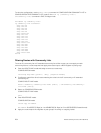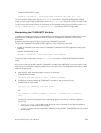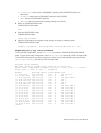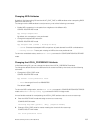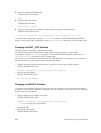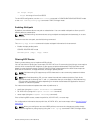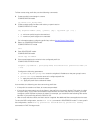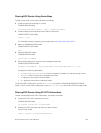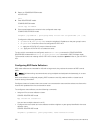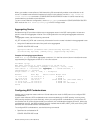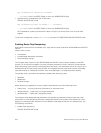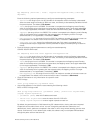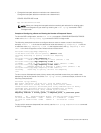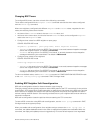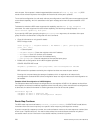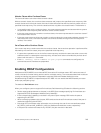
3. Return to CONFIGURATION mode.
AS-PATH ACL
exit
4. Enter ROUTER BGP mode.
CONFIGURATION mode
router bgp as-number
5. Filter routes based on the criteria in the configured route map.
CONFIG-ROUTER-BGP mode
neighbor {ip-address | peer-group-name} filter-list as-path-name {in | out}
Configure the following parameters:
• ip-address or peer-group-name: enter the neighbor’s IP address or the peer group’s name.
• as-path-name: enter the name of a configured AS-PATH ACL.
• in: apply the AS-PATH ACL map to inbound routes.
• out: apply the AS-PATH ACL to outbound routes.
To view which commands are configured, use the show config command in CONFIGURATION
ROUTER BGP mode and the
show ip as-path-access-list command in EXEC Privilege mode.
To forward all routes not meeting the AS-PATH ACL criteria, include the permit .* filter in your AS-PATH
ACL.
Configuring BGP Route Reflectors
BGP route reflectors are intended for ASs with a large mesh; they reduce the amount of BGP control
traffic.
NOTE: Dell Networking recommends not using multipath and add path simultaneously in a route
reflector.
With route reflection configured properly, IBGP routers are not fully meshed within a cluster but all
receive routing information.
Configure clusters of routers where one router is a concentration router and the others are clients who
receive their updates from the concentration router.
To configure a route reflector, use the following commands.
• Assign an ID to a router reflector cluster.
CONFIG-ROUTER-BGP mode
bgp cluster-id cluster-id
You can have multiple clusters in an AS.
• Configure the local router as a route reflector and the neighbor or peer group identified is the route
reflector client.
CONFIG-ROUTER-BGP mode
neighbor {ip-address | peer-group-name} route-reflector-client
212
Border Gateway Protocol IPv4 (BGPv4)



